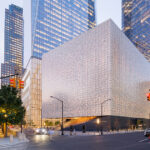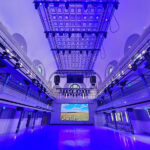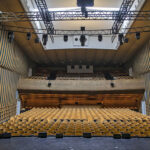Move to ‘Steel Mill’ Also Allows All Divisions to Join Under One Roof
A need, a great location and a vision has brought more possibilities and options to performers in Nashville as Moo TV (mootv.com) has taken ownership of a 70,000-square foot facility on a hill inside the city limits.
This former mill, rich in history, has allowed the Moo TV team to put all divisions of the organization under one roof. In addition, Moo TV can now offer current and potential clients rehearsal space, with enough space left over for like-minded production companies to set up shop.
The facility is branded, appropriately, “The Steel Mill.”

“The vision of it was simple,” Moo TV owner Scott Scovill says, hands entwined, leaning forward on a glass conference room table in a room with an impressive view of the city of Nashville. “Could we create a space where an artist and his team could build and rehearse in a situation that allows them to really put the show together?”
For the practical needs of Moo TV, the benefit can be easily understood by anyone who walks into their section of the facility. “How many warehouses can fly up to three 60-foot video walls, test them, run them, and not be in the way of each other?” Scovill asks.
Scovill is excited about bringing all aspects of his teams at Moo TV and Moo Creative under one roof, in close proximity to the downtown Nashville area than their previous location. The new facility has so many possibilities that the Moo crew is still having fun figuring out all the options for it as Nashville’s population in general, and arts in particular, continue to grow.
Also growing is the need for big concert productions to astound the crowds out of the gate at that very first show of the tour. So what’s an artist to do? There’s the Bridgestone, and then there is the Bridgestone sidecar, which is ever closer to being redeveloped because of its prime downtown location. And now, there’s The Steel Mill. Some of the acts that have used it already include Tears for Fears, Toby Mac, Kenny Chesney and Moo TV partners Jason Aldean, Jake Owen, Chris Stapleton, Dierks Bentley and Brad Paisley.

Nowhere Else to Go
For the true history of the facility, you must board the wayback machine and set it to New Jersey, circa World War II. There it was used to build planes for the war, which is why it includes two five-ton cranes and two two-ton cranes that are still part of the current structure. Later the historic bones of the building were carefully repurposed to Nashville and moved to the site of what is now Nissan Stadium. There it became part of the McCann Steel operation, which was founded in 1935. McCann Steel was relocated to the current site location around 1999. The Smythe family acquired and operated it as a steel/fabrication shop from 1974 to 2002. Jason Smythe, the youngest son, took over the facility and experimented with opening the space to many creatives, including allowing video shoots and band and concert production rehearsals there.
In 2010, Nashville was slammed by the Great Flood, and as readers of this magazine certainly know, many friends in the live event business were adversely affected. Moo TV was among those who were almost wiped out. “We had $1 million policy of flood insurance and we stopped counting the damage at $5 million,” Scovill says. In pulling what was left of his operation together, he recalled have heard of this mill up on the hill and reached out first to have some of his clients rehearse there. Then he asked if he could move in for a bit. “We were not the ideal tenants,” he says, smiling. “We were hosing mud off our gear in his parking lot. We made a mess of it for a while, but Jason was kind to us, which we appreciated, because we had nowhere else to go.”
While Moo TV survived, thrived and moved on, Scovill did not stop thinking about that space. Recently, Scovill approached Jason Smythe about taking it over, and a long dialogue ensued. “I told him I knew it was good for me, and thought it was good for him, but that we were not going forward until he was sure it was good for him.” They worked it out so that both sides were enthusiastic, and then getting a bank onboard ensued (“They don’t get what we do, but they are very happy now.”) When September dawned, it was in their hands. And now Moo TV is banking on the location, the size, and the fact that when you show up a road-experienced production manager meets you at the door to talk your talk and make sure the experience of the Steel Mill is a worthy one.
The specs are there, starting with a 50-foot high ceiling. The main feature is a cavernous space that is 220 by 80 feet that is completely clear. There is a lot of power available, more than anyone would need with several 400 amp units. Otherwise, it’s a blank canvas, so tours can build their sets and hang their lights and sound as they would in any arena or shed. Separated by a few beams is more space, making the total area 220-foot by 130-foot. Some of that space might be used for video production, and/or a nice greenroom is on the drawing board.
“Every band will want to do its own rigging and lighting, and any lighting or sound we would do would just get in the way of that if we put any lights or sound ourselves,” Scovill notes. He does add that as he’s co-owner of the LA rehearsal space CenterStaging, and their artists find rooms set up with modest PAs and lights, something that could happen in other spaces within the facility as The Steel Mill is developed. “But this space is for full production.” He acknowledges that creating a rehearsal is ambitious and maybe a little foolhardy. “This would be a really expensive undertaking unless you could move your video company into the building as well, plus Moo Creative, which hasn’t been in the same building since before the flood.”

Beyond Touring
But beyond the touring world, there are other possibilities. When this writer was given the cook’s tour of the facility by GM Devin Cundall, questions were asked about what this corner might be and what they might do with that space over there. Cundall would sometimes chuckle or shrug. “We’re inventing this space every day!” he says. “We’ll think maybe we can use this part for this, and build out from this wall to create an extra space for that.”
“I do think that television shows could be happening here, which would be advantageous being that we’re a video company,” Scovill says. “Need another camera? Oh, here it is, and sorry that took a whole two minutes.” To prove the point, it slips out that Nickelodeon had just shot a pilot on the premises, and if it were to get picked up, Moo TV would certainly welcome the show to the Steel Mill. “There have been other people who have reached out to us, like CMTV. I think it’s good for Nashville to have a creative space that not just the music industry can take advantage of. Everyone would like to see more of that. I’d love to be supportive of an entertainment community that grows in multiple directions.”
Also, office space for particularly progressive industry professionals will be ready on the second floor, which will have easy access with its own entrance. “How great would that be to attract legitimate talent and great companies serving the industry?” Scovill muses. “For not a ton of money, you could hang out your shingle here, and instead of working out of your apartment of a spot in a strip mall, you could say, ‘let’s meet at the Steel Mill.’ For the artist who might be curious about working with some up-and-coming designer, it could be, ‘Let’s grab lunch with him or her while we’re rehearsing there … the phrase, ‘I’m up at the Steel Mill’ could increase brand recognition.’ In the long run, this will be about synergy.”

One might think that having this space is a great “excuse” for the tour to go out the door with Moo TV products and teams. And Scovill admits that is part of it. But spending a day at the facility makes it is clear that that idea becomes a small part of the much bigger picture. When asked, Scovill pauses and then says, “A lot of the motivation of what we do here is whether something seems cool to do. Traditionally, someone might think of this, run the numbers, and be like, no way,” he laughs. “But here, it starts with, ‘Wouldn’t it be cool to have this be an industry hub?’ And when the answer becomes ‘Yes,’ then we run back and do the numbers.”
It should be noted that the “industry hub” idea isn’t totally new; there’s another campus in a small town in Pennsylvania that has garnered considerable notice. But whatever its other merits, it’s not in Nashville. “A lot of artist live [in Nashville], musicians, production people, there’s no flying people in or getting hotel rooms. And then you’ve got Nashville’s restaurants, nightlight, and everything else.” (A lot of which can be seen from patio of the facility.)
“If we create a community here and have more to offer than we had a year ago, it makes music more attractive. More importantly, it’s fun — it’s great to see all the activity as bands roll in and put it together, then roll out, ready to rock!”


